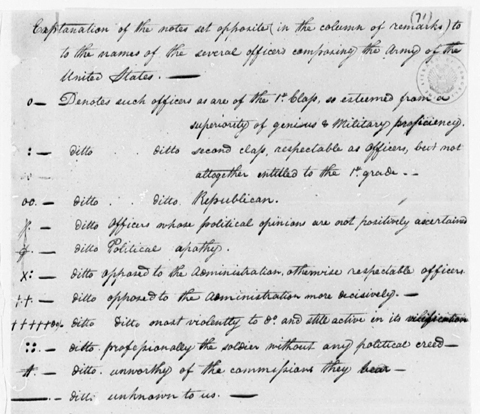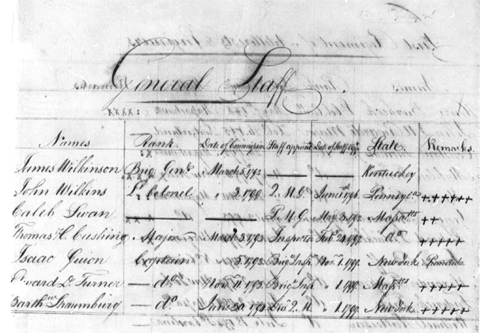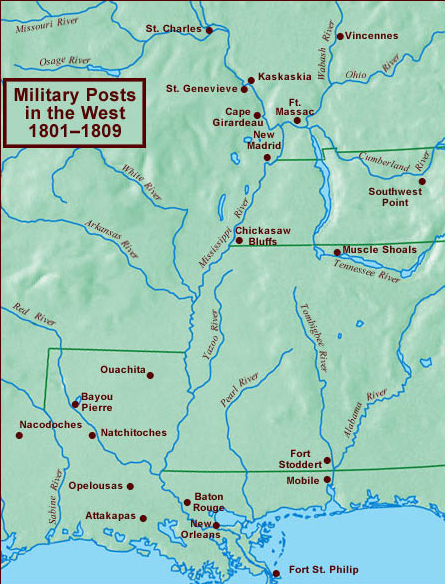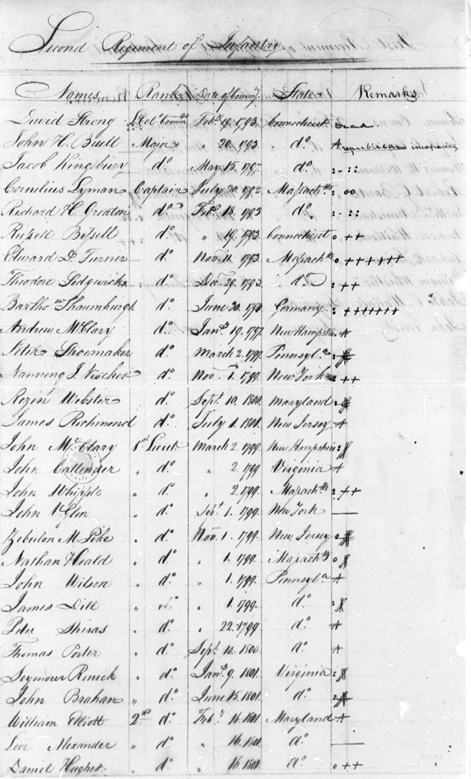The distribution of our little army to distant
garrisons where hardly any other inhabitant
is to be found is the most eligible arrangement
of that perhaps necessary evil that can be
contrived.
Jefferson’s Peacetime Army
Gallatin’s sentence neatly summarizes the Jeffersonian concept of a peacetime military establishment. The tiny force of 3,300 men that Albert Gallatin called “a perhaps necessary evil” was, in 1802, scattered along the new republic’s western frontier. In December 1801, President Thomas Jefferson‘s first annual message to Congress conceded the army’s weakness, noting “for defence against invasion their number is as nothing.” Far from being a source of consternation for the administration, this situation was exactly what Jefferson and his Cabinet wanted. Jefferson’s message went on to state that he did not consider it “needful or safe that a standing army should be kept up in time of peace.” Instead, he recommended that the nation rely upon state militia as its first line of defense. In the unlikely event of a foreign invasion, Jefferson expected the militia to buy the necessary time for the nation to raise more substantial military forces. In peacetime, a small number of troops to garrison a few vital western posts would suffice.
Jefferson’s claim that a large standing army was not “needful” was at least plausible. The United States was at peace, and no European power maintained sufficient military forces in North America to pose a realistic threat to American security. Anthony Wayne’s victory over the Indians of the “Ohio country” at the Battle of Fallen Timbers in 1794 had opened the southern part of that territory to white settlement. In Jefferson’s opinion, the maintenance of peace between whites and Indians on the western frontier would not require a large military force any more than would relations with the European powers.
The argument that it would not be “safe” to maintain a large peacetime army demands some explanation. Jefferson’s Republican party had clashed with the Federalists over military policy repeatedly in the 1790s. The crux of the matter was the Adams administration’s decision to build up the armed forces in response to French provocations during the so-called “Quasi-War” (1798–1800). Republicans feared that the Federalist-dominated “New Army” would, in combination with the controversial Alien and Sedition Acts of 1798, impose “tyranny” in the place of representative government. John Adams was not interested in establishing a military dictatorship, as he disbanded the “New Army” once France had offered acceptable peace terms. Nonetheless, Jefferson’s stated intent to keep the regular army small was in perfect accord with the desires of the newly-elected Republican congressional majority.
Lewis’s Codes for his Evaluations of Officers
To see labels, point to the image.
Library of Congress, Thomas Jefferson Papers, Image 280.
General Staff
Library of Congress, Thomas Jefferson Papers, Image 269
Jefferson’s General Staff was problematic, as the multiple crosses after five of the seven names indicate. The President discharged three of the five within a year after Lewis completed his assessment. Two of the staff who had served during the Revolution were retained despite their Federalist loyalty—the adjutant, Thomas H. Cushing, and the paymaster general, Caleb Swan. Edward Turner was retained, though he resigned three years later. Most controversial of all was Jefferson’s close friend, the commanding general James Wilkinson, on whom Lewis discreetly chose to register no comment.
Reduction in Force
In his December 1801 message to Congress, President Jefferson announced that Secretary of War Henry Dearborn had compiled a list of “all the posts and stations where garrisons will be expedient” and “the number of men requisite for each garrison.” As Dearborn’s estimate of the number of men actually required exceeded the Army’s authorized strength, Jefferson proposed that Congress consider a reduction in the force structure.
Jefferson’s proposal became the Military Peace Establishment Act, passed by Congress on 16 March 1802. On the surface, the act called for a substantial cut in the Army’s authorized strength. The force Jefferson inherited from the Adams administration fielded four infantry regiments and two regiments of engineers and artillery, with a manpower limit of 5,438 officers and men. From 1 June 1802, the reorganized Army would comprise only two regiments of infantry, a single artillery regiment, and a tiny Corps of Engineers. Authorized manpower would drop to 3,289 officers and men. Republican congressmen spoke of substantial savings to be realized from the reorganization.
Upon further examination, the reduction appears less radical. Since the Adams administration had not been able to recruit enough soldiers to fill the enlisted ranks, the Army’s actual present-for-duty strength was less than 3,600 when Jefferson took office. Only about 300 men would actually have to be discharged to meet the new limit. The real changes imparted by the reorganization were in the officer corps, not the enlisted ranks. The overall effect was to “Republicanize” the officer corps, which heretofore had been dominated by Federalist appointees.
Lewis’s Role
In the summer of 1801 the War Department supplied the President with a roster of the 269 officers, all career professionals, serving in the small U.S. Army as of 24 July 1801. Jefferson retained 131 of them, most but not all of the Republican persuasion. In the page shown here—the fourth of eleven—Lewis’s coded remarks are in the extreme right-hand column.[1]Donald Jackson, “Jefferson, Meriwether Lewis, and the Reduction of the United States Army,” Proceedings of the American Philosophical Society, Vol. 125, No. 2 (April 1980), 91-96.
As a result of the reorganization, eighty-eight of the approximately 230 officers lost their positions. In his capacity as the President’s secretary, Meriwether Lewis played an important role in the reduction process. Lewis prepared a report in which he classified the Army’s officers by military merit and by political affiliation, if known. Both of these factors were considered in identifying candidates for dismissal. Officers rated as “unworthy” were discharged almost without regard to political affiliation. But among the twenty-six “qualified” officers dismissed from the service (rated by Lewis as either first or second class), only one was a Republican, and that one had himself requested his discharge. Seven men in this group were known Federalists. The remaining eighteen were politically apathetic, had “no political creed,” or were of unknown political loyalties.
The 1802 reorganization provided an opportunity to appoint twenty new Republican officers. A new grade, ensign, was created to rank below that of second lieutenant. (This is the rank to which Nathaniel Pryor would be promoted after the expedition.) Ten ensigns were authorized in each of the two infantry regiments. Thus, even though eighty-eight officers were dismissed, the reorganized “1802” Army actually had only sixty-eight fewer officers authorized than in 1801. Moreover, the concentration of Republicans in the officer corps had substantially increased. Prior to reorganization, only 11 officers of 230 in the entire Army were known Republicans. After reorganization, the Army would include at least twenty-nine Republican officers in an officer corps numbering about 162. The Military Peace Establishment Act also provided a means for training good Republicans to fill future officer vacancies—the United States Military Academy at West Point. All in all, the Act of 1802 allowed Jefferson to carry out “a chaste reformation” of the Army.
Sources
Theodore Crackel, Mr. Jefferson’s Army: Political and Social Reform of the Military Establishment, 1801-1809 (New York: New York University Press 1987), Chapter 2.
Jefferson’s First Annual Message (8 December 1801), in Annals of Congress, Seventh Congress, First Session (Washington: Gales and Seaton, 1851).
Military Peace Establishment Act of 1802, in Annals of Congress, Seventh Congress, First Session (Washington: Gales and Seaton, 1851), 1306-12.
Notes
| ↑1 | Donald Jackson, “Jefferson, Meriwether Lewis, and the Reduction of the United States Army,” Proceedings of the American Philosophical Society, Vol. 125, No. 2 (April 1980), 91-96. |
|---|




